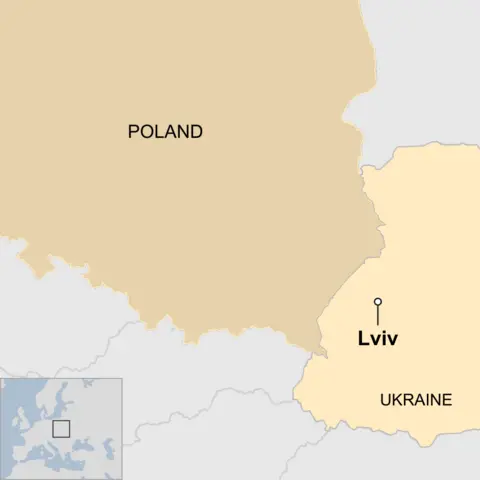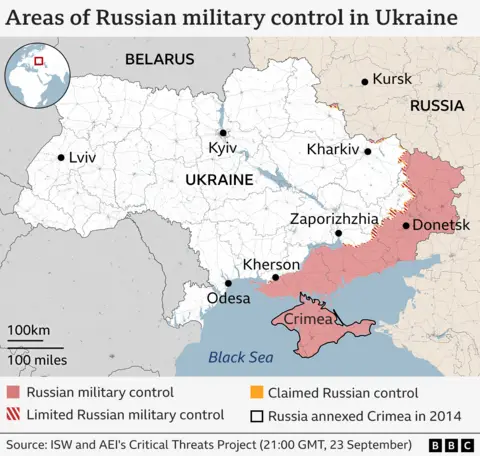Poland scrambles jets as Ukraine says five killed in Russian strikes
Stuart Lau,
Alex Boyd and
Gary O’DonoghueKyiv
 Reuters
ReutersFive people have died and tens of thousands have been left without power in Ukraine after intense Russian missile and drone attacks overnight, Ukrainian President Volodymyr Zelensky has said.
Ukraine’s neighbour Poland scrambled fighter jets in order to ensure the safety of Polish airspace, the Polish military confirmed. Allied Nato aircraft were also deployed.
Four members of one family, including a 15-year-old girl, were killed by a strike in the village of Lapaivka as attacks focused on the nearby western city of Lviv.
Russia’s defence ministry said it had successfully carried out a “massive” strike on Ukrainian military and infrastructure targets.
Another family member was injured, as were two neighbours, in the strike that killed their relatives in Lapaivka.
One person also died in Zaporizhzhia. Zelensky said Russia fired more than 50 missiles and around 500 attack drones.
Lviv endured several hours of strikes, leading to the suspension of public transport services and the cutting of electrical supplies.
The Ivano-Frankivsk, Chernihiv, Sumy, Kharkiv, Kherson, Odesa, and Kirovohrad regions were also targeted as well as Lviv and Zaporizhzhia, according to Zelensky.
He added: “We need more protection and faster implementation of all defense agreements, especially on air defense, to deprive this aerial terror of any meaning.
“A unilateral ceasefire in the skies is possible – and it is precisely that which could open the way to real diplomacy.”
The Russian assaults came days after a US official said the US would support Ukraine launching deep strikes inside Russian territory.
“Polish and allied aircraft are operating in our airspace, while ground-based air defence and radar reconnaissance systems have been brought to the highest state of readiness,” Poland’s operational command said in a post on X.
At 05:10 (02:10 GMT), all of Ukraine was under air raid alerts following Ukrainian Air Force warnings of Russian missile and drone attacks.
Russia continues to focus its attacks on Ukraine’s energy infrastructure as winter approaches.
Kyiv’s energy ministry said overnight attacks caused damage in Zaporizhzhia, Chernihiv and Sumy.
In Zaporizhzhia, Russia’s overnight attack left “more than 73,000 consumers… without electricity” after a power plant was struck, according to Ivan Fedorov, the regional governor.
A woman was killed and several others injured in the region.
A 16-year-old girl was among those receiving medical assistance, Fedorov added, posting photos apparently showing a partly destroyed multi-storey block and a burnt-out car from the site of the attack.
Emergency outages were implemented in Chernihiv and Sumy, the energy ministry added.
Lviv’s mayor Andriy Sadovyi said part of the city – 70 km (43 miles) from the border with Poland – had no power, adding that city’s air defence systems were engaged heavily in repelling first a drone and then a Russian missile attack.

Public transport in Ivano-Frankivsk, another western city, would “start running later than usual” on Sunday, its mayor said.
At around 06:00 (03:00 GMT), Ukraine’s Air Force said all of the country was under the threat of fresh Russian missile attacks, following hours of air raid alerts and warnings of drone and missile attacks.
Since the start of Russia’s full-scale invasion of Ukraine in 2022, its forces have occupied most of Ukraine’s eastern Donbas region, including Luhansk and Donetsk.
Russia currently controls around a fifth of Ukrainian territory, including the Crimean peninsula, which it annexed in 2014.
In Russia, air defence units destroyed 32 Ukrainian drones overnight, the state-owned RIA news agency reported on Sunday, citing data from Russia’s defence ministry.
Ukraine has also been stepping up strikes on Russian oil refineries, leading to petrol shortages in parts of the country.
Last week, US Special Envoy to Ukraine Keith Kellogg said on Fox News that the US would support Ukraine launching deep strikes inside Russian territories.
“The answer is yes, use the ability to hit deep, there are no such things as sanctuaries,” Kellogg said when asked if it was US President Donald Trump’s position that Ukraine could conduct long-range strikes.

Meanwhile, another Nato member – Lithuania – had to close its airspace briefly after objects were spotted, following recent incidents in Denmark, Norway and Germany.
Lithuania suspended flights at its largest and busiest Vilnius airport for several hours, before reopening it at 04:50 (01:50 GMT) on Sunday.
The airport’s operator said the flight suspensions and diversions were “due to a possible series of balloons heading toward Vilnius Airport”.





